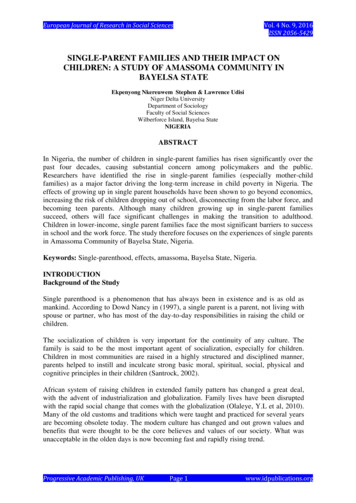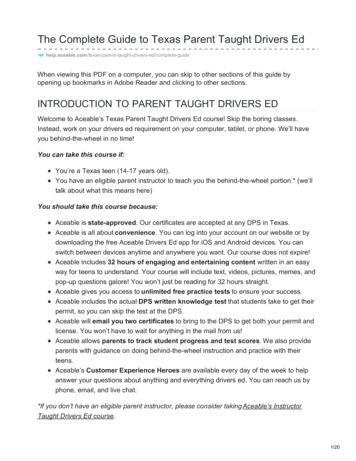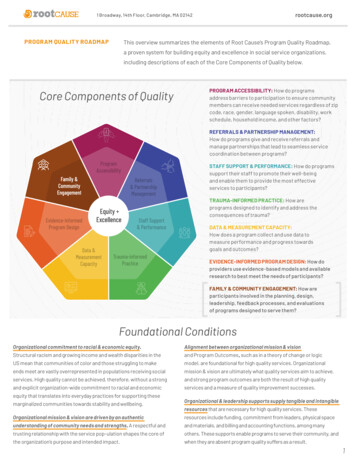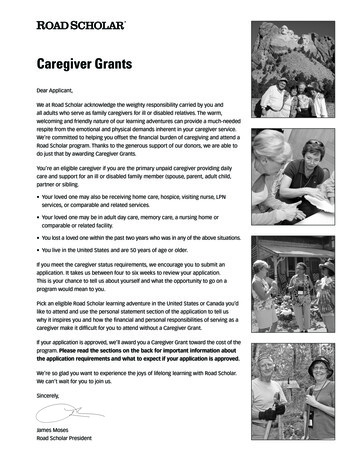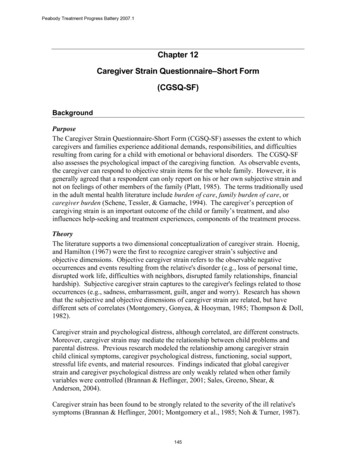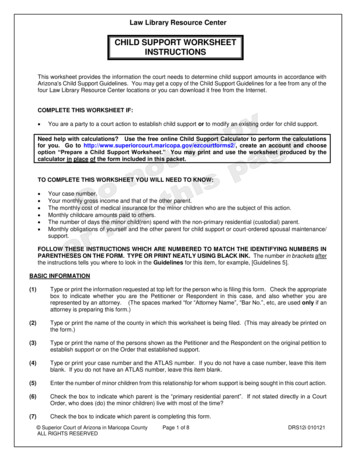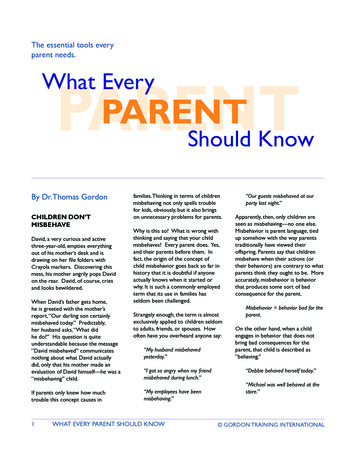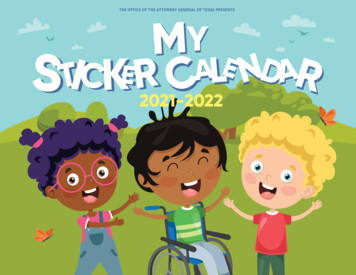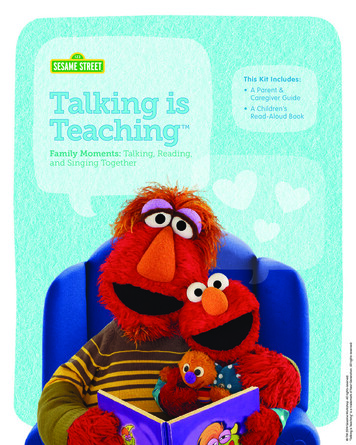
Transcription
/TM 2014 Sesame Workshop. All rights reserved.“Talking is Teaching” is a trademark of Next Generation. All rights reserved.This Kit Includes: A Parent & Caregiver Guide A Children’s Read-Aloud Book
Welcome, parents and caregivers!Your child may still be tiny, but big things are going on in that little head.Kids learn about the world around them all the time. You can make every momentof these important early years count—and have lots of fun doing it!Your child’s brain starts forming beforehe’s even born. Children learn best whenthey do things with someone they love —like you! You have the power to shape yourchild’s learning by sharing everyday lovingmoments together. Babble back and forth.Read a story while cuddling. Sing a lullaby atbedtime. These activities can help yourchild learn language skills.Sesame Workshop and Too Small to Failcreated this guide to help you fill each day withwords, stories, songs and love.Inside are tips and activities around: talking—speaking and listeningwith your child, reading—enjoying books and storiestogether, and singing—learning through music and song. You will also find Milestone Cards to useas your child grows.You know your little one best. Choose theideas you want to explore with your child and let the fun begin!talkingisteaching.org sesamestreet.org/talking1 /TM 2014 Sesame Workshop. All rights reserved. “Talking is Teaching” is a trademark of Next Generation. All rights reserved.
Brain Food: Between ages 18 and 24months, most toddlers can say about50 different words. Soon after, they maysay several new words each day!Talking togetherSo much brain growth happens through talking and listening.Your little one is busy learning sounds, words, and phrases. She is alsomaking connections between them and what she sees. Young childrennaturally explore the world. They touch, feel, see, hear, and taste.To begin rich conversations with your child, draw on her five senses.Here are some ideas:SPARKING CONVERSATION2How does it feel?Touch is often how childrenexperience the world. Let yourchild feel certain textures.Then help him give each aname (“Your sweater is reallysoft.” “The carpet is fuzzy.”).Do you see what I see?Even looking out the windowtogether and pointing at whatyou see is an opportunityfor conversation. (Your child’sbabbles, coos, and gesturescount!)Breathe deeply.When you’re taking a walk,point out the smells in yourworld (“Mmm.this breadfrom the bakery smells fresh!Let’s smell it!”).It’s a matter of taste.Talk about how things taste inyour mouth (“Does that juicywatermelon taste sweet?”).This will help your child to buildher vocabulary.talkingisteaching.org sesamestreet.org/talking /TM 2014 Sesame Workshop. All rights reserved. “Talking is Teaching” is a trademark of Next Generation. All rights reserved.Listen up! Sounds areeverywhere. When youare out, talk about what youhear (“Do you hear thecars beeping?” “The wind israttling the branches.”).Helping your child tune in tosounds is a way to buildlistening skills.
A Peek Into Parenting: Sophia is trying differentkinds of foods. Each new taste is a surprise!Dad makes eye contact with Sophia. He respondsto her coos, babbles, and squeals. He also comments onwhat’s happening (“You really like those pears, don’t you?Yummy, yummy in Sophia’s tummy!”). Mealtimes might bemessy, but Dad is using these moments to help Sophialearn to listen and speak.Tell Me a Story: Tell your childthe stories you were told whenyou were his age. Don’t forgetfavorite stories about your family.(Remember: Grandparents,especially, may be great storytellers.)This will help your child develophis storytelling skills, whichare an important part of learningto read. It’s also a great wayto bond with him, and you cando it anywhere.Talk About It: Though your child may not be talking yet, she is learningwords as you speak to her. At feeding time, have fun with language!Use words to talk about new and familiar foods she tries. And as yourchild watches you make food, tell her what you are doing.talkingisteaching.org sesamestreet.org/talking3 /TM 2014 Sesame Workshop. All rights reserved. “Talking is Teaching” is a trademark of Next Generation. All rights reserved.
Brain Food: Six- to nine-month-oldbabies will copy adults. They may turnmore than one page at a time. By age 1,they are better able to control theirhands and can turn single pages.Reading togetherCuddle up with your child and enter the world of a story. Books arebrain boosters. The more your child is read to from the verystart, the more his brain will grow and language will develop.Here are some tips to help you enjoy sharing a story together.STORYTIME STRATEGIESMake connections.Tie the story to your family’sexperiences (“Oh, look, the boyin the picture has a balloon.Remember when you andyour sister got balloons at theblock party?”).Bring the story to life.Use different voices for eachcharacter. Act out scenes withbody movements or soundeffects. You can simplifythe reading in any way thatfeels right, such as talkingmore slowly.4talkingisteaching.org Get to know books.Help your child explore thedifference between thefront and back covers of abook. Help her to tell whethera book is upside down.And point out how you readthe story from left to rightwith your finger.Book break! Visit thelibrary often. Even makea quick stop between errands.Most libraries have bookseven for the littlest readers.And they might offer aweekly story or singing timefor kids.sesamestreet.org/talking /TM 2014 Sesame Workshop. All rights reserved. “Talking is Teaching” is a trademark of Next Generation. All rights reserved.Read everything aroundyou. Print is everywhere, notjust in books. Together, noticeand read signs, cereal boxes,letters that come in themail, menus, ads on the sideof buses, and so on.
Choosing a Book as YourChild Grows:A Peek Into Parenting: James is in his favoriteplace: Mommy’s lap! And they’ve just started reading.Mom asks, “Can you help me turn the pages?”James excitedly grabs at and turns the pages before Momhas even had a chance to read the words! But that’s OK.The experience is more important than finishing the story.So Mom talks about the pictures on each page. She doesn’tworry about reading all the words.Babies love sturdy board, cloth,or plastic books. Look for simplerhymes, repeated text, andcolorful pictures.Read About It: Invite your child to get involved each time you read together(“I see a dog on this page. Where’s the dog?”). And don’t be surprisedif your child wants the same book again and again. Reading the same thingmany times is great for building language.Toddlers might be interestedin books about animals, trucks,or food. They also may like tosee kids doing familiar things suchas playing and going to bed.Older children like books withsimple text that is easy to remember.Counting books, alphabet books,and search-and-find books arealso great choices.talkingisteaching.org sesamestreet.org/talking5 /TM 2014 Sesame Workshop. All rights reserved. “Talking is Teaching” is a trademark of Next Generation. All rights reserved.
Brain Food: As early as zero to threemonths, a familiar song can help babiesfeel safe. Songs are as important as afavorite blanket, toy, or stuffed animal.Singing togetherSongs are a great way for your child to learn language and buildvocabulary. Singing also helps your child bond with you. Making soundshelps babies and toddlers learn how sounds are put together. These are thebuilding blocks of language and literacy. They also help create a lifelong loveof music! Here are some ways you can sing and make music together.ROCK WHAT YOU’VE GOT6Anything can become aninstrument. An empty oatmealor plastic container makes agreat drum. A paper-towel rollcan become a horn. Playing withinstruments helps children learnmore about rhythm and sounds.Mellow out with music.The next time your child iscranky, sing him a lullaby orfavorite song. He’ll be comfortedby the sound of your voiceand be exposed to some newwords, too.My kind of music!Does your child like a certaintype of “your” music, suchas rock or hip-hop? Turn it upand dance together!Traffic jam! Even afrustrating experience suchas being stuck in traffic isa chance to build languageskills. Encourage your childto repeat “Beep, beep!” afteryou (try it loud and soft, fastand slow).talkingisteaching.org sesamestreet.org/talking /TM 2014 Sesame Workshop. All rights reserved. “Talking is Teaching” is a trademark of Next Generation. All rights reserved.Move it! Encourageyour child to clap, jump,jiggle, and stomp to music.Your baby can wiggle herarms, legs, hands, andfeet (or you can help).Singin’ my favorite song.Use a well-loved song to helpyou move from one routineto another. Even diaper-changingis a chance to communicateand develop language.Make eye contact and singto your baby.
A Peek Into Parenting: Alisia is splashing aroundduring bath time, playing with her toys. Her momstarts chanting in a singsong voice as she washesAlisia (“Here are your ears, here are your knees, here areyour toes, here is your nose”) as she points to those body parts.She’s bonding with Alisia and introducing new words.Alisia doesn’t care—or even know—if her mom’s voice is a littleoff-key. She and Mom are too busy enjoying themselves!Sing About It: During bath time, both you and your child can furtherbond, relax, and have fun together. Try chanting or singing a made-uptune as you splash toys gently in the water (“Rubber Duckie—splash!Little boat—splash! Blue fish—splash!”).Sing a Song: Your child willlove to hear his name sung in afamiliar song. Don’t worry abouthow you sound! He will delightin hearing your voice.(To the tune of “Twinkle, Twinkle”)Twinkle, twinkle, [child’s name]-star,How we love you as you are.We all love to play with you,Mommy, Daddy, Nana, too![Substitute any names of lovedones in your child’s life.]Twinkle, twinkle [child’s name]-star,How we love you as you are.talkingisteaching.org sesamestreet.org/talking7 /TM 2014 Sesame Workshop. All rights reserved. “Talking is Teaching” is a trademark of Next Generation. All rights reserved.
MilestoneCardsEach of the cards on the following pagesshows literacy milestones from ages 0 to 3.They suggest ways you can help yourchild’s brain develop. (Keep in mind thatyour child grows at her own pace.)Cut out the cards and refer to each asyour child grows. You might put the cardson your refrigerator or a bulletin board.As your child gets older, you can pass alongthe cards to other parents who mightenjoy them.8talkingisteaching.org sesamestreet.org/talking /TM 2014 Sesame Workshop. All rights reserved. “Talking is Teaching” is a trademark of Next Generation. All rights reserved.ADDITIONAL RESOURCESFor more ideas and informationabout how to make the most of talking,reading, and singing with yourlittle one, visit:Talking is Teaching attalkingisteaching.orgEveryday is a Reading and WritingDay at sesamestreet.org/literacyCDC’s Essentials for Parenting atcdc.gov/parents/essentials
Newborns to 3-month-olds may tell one person’s voice from another’s, tell speech from other sounds, and begin to remember things.MILESTONE MOMENTSs e s a m e s t r e e t.o r g / t a l k i n gt a l k i n g i s t e a c h i n g .o r g /TM 2014 Sesame Workshop. All Rights Reserved. /TM 2014 Sesame Workshop. All Rights Reserved.MILESTONE MOMENTSs e s a m e s t r e e t.o r g / t a l k i n gt a l k i n g i s t e a c h i n g .o r g6- to 9-month-olds may copy or say the same sounds over and over,and say mama and dada, know the names of people and things, and clap and use their bodies to speak with others. copy sounds and movements, turn toward a parent or caregiver’s voice, and make their own sounds.MILESTONE MOMENTSs e s a m e s t r e e t.o r g / t a l k i n gt a l k i n g i s t e a c h i n g .o r g /TM 2014 Sesame Workshop. All Rights Reserved. /TM 2014 Sesame Workshop. All Rights Reserved.MILESTONE MOMENTSs e s a m e s t r e e t.o r g / t a l k i n gt a l k i n g i s t e a c h i n g .o r g3- to 6-month-olds may9- to 12-month-olds may communicate by babbling or pointing, understand more words and commands, and respond to their own name and connect thenames of others.
Talking: Talk to your baby a lot. Look herin the eye. Enjoy her responses: a waving arm,a smile, kicking legs, and so on. Engage herwith language (“What a strong arm!” “Thanksfor that sweet smile!”).Talking: Even feeding a newborn isa conversation. Your baby fusses or criesand you offer him milk— the beginning ofcommunication! Babbles and coos are hislanguage as he strengthens his speechmuscles and experiments with sound.Singing: Celebrate the new soundsyour baby is making. Echo themand even make up a little songor chant using just thosesounds. You can babbleback and forth!Reading: It’s never too early to read to yourchild. As part of her bedtime routine, readher a book or two. Soon your baby willassociate certain stories with falling asleep. /TM 2014 Sesame Workshop. All Rights Reserved. /TM 2014 Sesame Workshop. All Rights Reserved.Reading: Your baby may have favoritebooks already! Create his own library on ashelf or in a stack near his crib. He’ll soon knowthat those books are his special things.Talking: Fill everyday routines with talk.Build vocabulary by telling your child what you’redoing (“One sock two socks. Now we can puton your shoes. One shoe two shoes.”).Talking: Lovingly acknowledge yourbaby’s “nonsense” words, such as ba ba orma ma, by repeating them or extending theidea (“Yes, ba, ba. Baa, baa black sheep!”“Mama’s right here! Peek-a-boo!”).Reading: Point out signs around you(“Let’s buy some apples. See the sign? It says‘apples.’”). This teaches that print has a purposeand words are everywhere, not just in books.Reading: On your desktop or smartphone,make a “Who Loves Baby?” slide show of photosof family and friends. Talk about each photo(“Who loves Alex? Uncle Jorgeloves Alex.”). /TM 2014 Sesame Workshop. All Rights Reserved.Singing: Babies enjoy wordplay as theyform a sense of humor. Use your baby’sname in a rhyming chant or song (“Silly Lily,Silly Lily, Silly Lily.”). /TM 2014 Sesame Workshop. All Rights Reserved.Singing: Use your body as an instrument:Clap, snap, whistle, and snort! Hearingdifferent kinds of sounds helps your child buildlistening skills. It also engages his attention.Singing: Let yourbaby make some noise!Give her a woodenspoon and a plasticcontainer. She’ll lovemaking simplerhythms.
12- to 18-month-olds may enjoy touching, grabbing, squishing, and tastingjust about everything, say more names of familiar people or objects, and rely more on memory for words or songs.MILESTONE MOMENTSs e s a m e s t r e e t.o r g / t a l k i n gt a l k i n g i s t e a c h i n g .o r g /TM 2014 Sesame Workshop. All Rights Reserved. /TM 2014 Sesame Workshop. All Rights Reserved.MILESTONE MOMENTSs e s a m e s t r e e t.o r g / t a l k i n gt a l k i n g i s t e a c h i n g .o r g2-year-olds may use sentences of two to four words, point to things or pictures when they are named, and repeat your words and phrases. be able to act more on their own, use simple two- and three-word sentencesand start asking questions, and learn new words quickly while understandinga lot more than they can say.MILESTONE MOMENTSs e s a m e s t r e e t.o r g / t a l k i n gt a l k i n g i s t e a c h i n g .o r g /TM 2014 Sesame Workshop. All Rights Reserved. /TM 2014 Sesame Workshop. All Rights Reserved.MILESTONE MOMENTSs e s a m e s t r e e t.o r g / t a l k i n gt a l k i n g i s t e a c h i n g .o r g18- to 24-month-olds may3-year-olds may carry on conversations using two to three sentences, complete a sentence or rhyme in a favorite story, and know by sight the first letter of their name.
Talking: Your toddler may be veryinterested in your cell phone. Give hera toy phone to play with and to copy your“conversation” style.Talking: Close your eyes and explorewith your ears! Say, “Let’s listen carefully.What do you hear?” Take turns naming thesounds around you (cars moving, doorsclosing, people talking).Reading: Read street signs while you drivearound or take a neighborhood walk (“Look atthe big, red stop sign. S-T-O-P spells stop.”).Reading: Let your child hold anything thatcan be read: menus in a restaurant, themail as you bring it from the mailbox. Point towords and read them aloud. /TM 2014 Sesame Workshop. All Rights Reserved. /TM 2014 Sesame Workshop. All Rights Reserved.Singing: Sing the alphabet song with yourchild until he can sing it by himself. Praise yourchild for trying and succeeding.Talking: Notice sounds around theneighborhood. Talk with your child about whoor what might be making them.Talking: Even writing an e-mail can bea conversation starter! Talk to your child aboutwhom she would like to send a messageto and what she would say.Reading: Together, make a storybook ofyour child’s drawings (just staple them togetherand have your child draw a cover). Then havehim “read” you the book.Singing: If your child is in childcare, she islikely learning new songs there. Have her teachyou a song she knows! /TM 2014 Sesame Workshop. All Rights Reserved. /TM 2014 Sesame Workshop. All Rights Reserved.Reading: Help your child start to recognizeletters in the alphabet. Point them outwhen you see them (“Look, there’s the letter A.A is for apple!”).Singing: Make up songs while you wait inline or run errands. Try putting newwords to a familiar song or create a chant(“Waiting, waiting for thebus, come on, bus andpick us up!” or “Going,going to the storeto buy carrots.We need more.”).Singing: As you sing your child’s favoritesongs, substitute new words for familiarones (“Row, row, rowyour stroller, gentlydown the street ”).
A creation ofThe nonprofit educational organization behindSesame Street and so much more.Sesame Workshop is the nonprofit educationalorganization behind Sesame Street which reaches156 million children across more than 150 countries.The Workshop’s mission is to use the educationalLa organización educacional sin fines de lucropowerof mediato helpchildrengrowque produceSesameStreety muchoeverywheremás.smarter, stronger, and kinder. Delivered througha variety of platforms, including television programs,digital experiences, books and community engagement,its research-based programs are tailored to the needsof the communities and countries they serve. For moreinformation, visit us at sesameworkshop.org.Produced in collaboration withToo Small to Fail, a joint initiative of Next Generationand the Bill, Hillary and Chelsea Clinton Foundation,aims to help parents, communities and businesses takemeaningful actions to improve the health and well-beingof children ages zero to five, so that more of America’schildren are prepared to succeed in the 21st century.Too Small to Fail is focused on closing the “word gap.”Studies have found that by age four, children inhigher-income families hear approximately 30 millionmore words than children in low-income families.This disparity in hearing words from parents andcaregivers translates directly into a disparity in learningwords. And that puts our children born with the fewestadvantages even further behind. Among those born in2001, only 48 percent of poor children started schoolready to learn, compared to 75 percent of children frommiddle-income families.The “word gap” is a significant but solvable challenge.Too Small to Fail is about parents, caregivers, otherconcerned individuals, and the private sector comingtogether to take small, research-based actions with bigimpacts. Learn more at toosmall.org, and on Twitter@2SmalltoFail.Generous support provided by /TM 2014 Sesame Workshop. All rights reserved.“Talking is Teaching” is a trademark of Next Generation.All rights reserved.
[Substitute any names of loved ones in your child's life.] Twinkle, twinkle [child's name]-star, How we love you as you are. A Peek Into Parenting: Alisia is splashing around during bath time, playing with her toys. Her mom starts chanting in a singsong voice as she washes Alisia ("Here are your ears, here are your knees, here are
